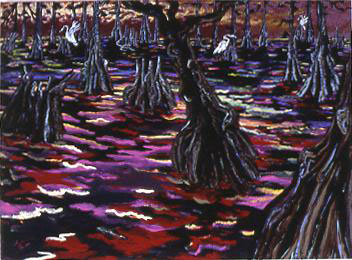
The Atlanta Constitution
Thursday, August 11, 1988
‘Unnatural Landscape’ Is a Modern Explosion
By Catherine Fox
Visual Arts Critic
An artist working in the ‘80s has to find new ways of dealing with landscapes.
Making monumental, realistic paintings, as Alfred Bierstadt did on the Western frontiers, seems outdated in an era in which the thought of wide-open spaces is more likely to conjure up images of a freeway at 3 a.m. than purple mountains’ majesty and fruited plains. It’s not only the view but also the optimism that’s missing. The wonderment implicit I that 19th-century American artist’s paintings are not expressive of an age in which natural resources belong on the endangered species list.
“The Unnatural Landscape,” a group show that rambles throughout Fay Gold Gallery, surveys ways that contemporary artists grapple with the problem. The original thrust of the exhibition, which includes artists from all over the country, concerned the idea that the landscape genre, like much of current art, has become more conceptual than perceptual, that artists are exploring how we see nature and how we turn nature into art rather than describing the thing itself.
But the selection of drawings, paintings and sculpture dilutes that idea. The apparent desire to include as many gallery artists as possible and the necessity of borrowing works – sight unseen – from other dealers has resulted in a show in which the term “unnatural landscape” comes to mean any landscape that isn’t straightforward and realistic.
The paintings of Robert Jessup and Steve Heyman, beautiful though they are, are psychic landscapes informed by a surreal tradition. Similarly, Nina Beall’s “Black Lake, La.” With its “unnatural” red, pink and cream and heavily impasto brushwork, is an offspring of early modern Expressionism. And it is stretching the definition of landscape awfully thin even to include Adrienne Anderson’s wonderful vase or Melissa Miller’s still life.
The flawed curatorship, however, is far from fatal. Even though the show fudges on its stated premise, it remains a thoughtful exhibition and one so chock full of wonderful paintings that even the ordinary pieces don’t get in the way. (partial)